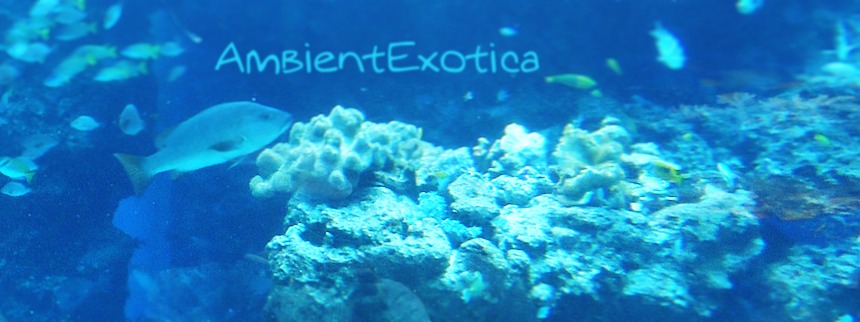
Zoë Blade
Hello Calm
2010
Hello Calm by British composer Zoë Blade presents Ambient music of the most melodious kind, that's the description in a nutshell. But the essence of the above sentence is all the more surprising and intriguing, for her work is strictly melody-related and does often feature anything but a hookline: while melodious Ambient music exists for decades, Blade's compositional pattern is usually comprising of a four- or five-note melody on the synthesizer, and yes, that's about it. Reverse minimalism would be an apt term, as it is not the melodies that are missing, but eclectic beat structures; usually, it is vice versa in the vast realms of today's electronic music. These melodies better be catchy, or else the enchanting nature cannot unfold. Fortunately, in most cases this reduced or different kind of minimalism works splendidly. There are many arrangements that lack a percussive device or beat. Neither of the twelve tracks belongs to the Drone genre, nor to the Glitch tradition. The true driving force leads to the glitzy world of Pop. Those Pop structures plus Ambient soundscapes usually result in, well, Pop Ambient, but this is yet again a subgenre of its own and cannot be applied to Hello Calm. Despite Zoë Blade venturing into slightly darker tones or keys in minor, there are eupeptic riffs aplenty to be found. The melodies are furthermore rather detailed and precise, a term I use in lack of a better one. The aural sceneries aren't all too thick and heavily texturized, but still show different attributes, with one rather quirky one: synth choirs, deemed out of fashion for a few years now, but happily resurrected here to great effect. Read more about all of the twelve tracks below and/or listen to the album in full at Zoë Blade’s Bandcamp page while you are reading this review.
Zoë Blade’s aqueous dreamscapes take off with the slow fade-in of Inner Harp, a whistling sonar-infused artifact of warmth which presents uplifting bubbling pads that swirl cheerfully around a warm, distantly accordion-evoking synth stream, further rounded off by galactic strings. The upswell and downfall of this aorta are the only remnants of a blithesome darkness, everything else is well-saturated and shimmers vivaciously. It’s a technicolor opening of an eminently phantasmagoric journey that is continued with Sunshine, and at first glance it seems that the merriment is replaced with profoundness, as an angelic four-note melody is droning along, only accentuated by dubby basslines and a gently clave-like percussive particle. And indeed is this song much deeper and more entrancing; the term trance isn’t too far off, as a second, much more piercing four-note melody complements the liquid balminess for a short time, functioning as a camouflaged reminiscence of the Trance genre where such melodic hooks of similar proportions are right at home. However, the soothing panorama is never destroyed, and the introductory and virtually omnipresent melody is more important than the other incarnation. The following Ġgantija Phase can be considered as the centerpiece of Hello Calm, as it is the longest track on the album, but also one of the most ambiguous yet focused ones. It launches with deep submarine-like machine drones, but they do not sound metallic or brazen, as this impression solely derives from the synth setup which couples an abyssal drone with a brighter New Age-inspired surface. The tone sequences are ultimately cherubic, and the slight darkness is definitely perceptible, but never threatening or about to swallow the luminosity. Zoë Blade maintains this state throughout the composition, neglecting all shakers, snares, bass drums and filters in the universe in order to present the reduced base frame in the form of a glaring melody. As such, it is carved out properly, sounding well-exposed and full. No backing drones are featured, no reverb or echo is attached which gives this particular offering the scent of a demo track, but that’s fine by me, seldom heard and therefore all the more precious. I would thus call Ġgantija Phase a minimal piece, but refrain from doing so due to the wrong assumptions this would generate.
The fourth track Sea Of Calm not only links back to the front artwork, but comprises of the most fluid synth structures thus far, the listener literally submerges in the three iridescent droplets which are repeated in juxtaposition to classic piano sprinkles and heavily oscillating synth strings. Percussive elements are again amiss, the simplistic tones do not only remain in the limelight, the melody itself is the limelight. While the short Sine Wave Stream 1 presents an ecclesial vignette of a synth choir and remains predominantly in minor keys, the dolefulness continues with the piano arrangement called Dead Inside which becomes much more anthemic once the superimposition of majestic synth strings is unleashed. They work to great effect, as they either expand the gloominess of the piano melody or inject a magnanimous dose of solemnity and conviviality to the mix, leading away for short moments from the crestfallen atmosphere. This track has a cinematic feel to it and reminds me of the 16-bit era of RPG video games where each melody had to transport a maximum of the desired mood. Neon In Midnight Rain is another interlude, this time depicting a film noir-inspired setting of deep drones, galactic pads, a grave piano melody in high regions and dusky synth strings complete with an artificial choir in the background in the veins of Future Sound Of London’s Lifeforms, one of the influences cited by Blade. The following Gliding Over Mountains is much more lofty and saccharine. It is surprisingly similar to Lemongrass’ Lake Of Lava due to its blurry space flute, the wave-like synth washes and the perfectly content mood. It’s a very strong track that is further elevated by a glorious synth choir in the second phase. If you do not mind the slightly clichéd use of this choir-esque device, you are in for a mellifluous yet deep tune.
The third interlude Swimming In The Deepest Oceans expands the intrinsic sound pool of the album with the inclusion of a Balearic sun-soaked guitar that is placed in adjacency to frosty sine waves and a deep synth choir. If you haven't found out by now, you really need to be into this particular kind of sound. Triumphant Epilogue, on the other hand, further refines Blade's style, possibly in the boldest way: gleaming synth streams get together to form the most beautiful, positive and outright joyful five-note melody which is accompanied by vibrant hi-hats and vivid beats. This is an Ambient tune that allows you to do your daily workout routine while you're listening to it, and I have to admit that it has now become a regular part of my running playlist, as it is pitch-perfect for daylight activities and underlines gracious or coordinated body movements all the better. Its positive aura will definitely kindle a good mood, I'm sure. Pistyll Rhaeadr immediately connects with the ebullient joy of the preceding track and features similarly pristine and colorful strings on a downbeat full of gently dropped beats, echoey claves and soft hi-hats. The thermal heat and esprit it delivers are heart-warming. Once more, Blade gives a prime example of a seemingly easy and hence all the more enchanting melody. The final Wallking In The Rain might be too sugar-sweet for the majority of Ambient listeners, as it is in fact a Cosmic Pop song with vocoded cylon vocals, a breakbeat, modulated organ glitz and whistling star lights. This last track does nothing for me, as I've long turned my back against this mellow vocoder kitsch, but since it is placed at the end of the album, it can be easily avoided. My remarks really refer to the diehard core of Ambient listeners. Everyone else who enjoys the distinct melancholy of a robotic radio-friendly cut will probably encounter the opposite emotion and hail this as the best piece. So be it.
Zoë Blade’s Hello Calm is an album that captures a lightweight innocence and transports this feeling via synth-heavy sound waves to the ears of the listener. If there is one particular strength that truly distinguishes Blade's Ambient compositions from the well-populated genre, it is the merciless focus on sharply carved-out but eternally smooth melodies. You can literally hum along to each and every tune with ease. Don't expect convoluted drone layers, eclectic beat patterns or the misty reverberation of plinking chimes which fades into the pitch-black distance. No, this is essentially an album that gathers twelve simple – but not simplistic – melodies. I am using the term simple on purpose and do not intend to degrade the compositional qualities or ornaments in any way. I use it in order to explicate Blade's straightforward approach. Some tracks really do sound like additions to an extended single or EP, i.e. the inclusion of a certain hook or riff sans beats or vocals. Another particularity is the frequent use of a synth choir preset, not a bad choice per se, since such an element has already been prominently featured in Brian Eno’s Music For Airports (1978), for instance, and floated through the history of music ever since. Its addition to a 2010 album, however, is a different story, so the listener must in one way or the other be willed to feast on the characteristic traits of this texture. Once this is accomplished, there is lots to enjoy on Hello Calm. It is downright refreshing to hear crunchy, clear melodies without the usual molecules and post-effects that are applied to the Glitch and Drone genre. If you're fond of the transformation of euphonious Pop melodies into balmy Ambient settings, Hello Calm is a top choice to make, as this kind of openness is less and less apparent in a genre that is nowadays nurtured by faster processors which allow the stacking of ever-increasing layers. Zoë Blade provides a deliberate counterpoint, at least for the time being.
Further reading:
Ambient Review 138: Zoë Blade – Hello Calm (2010). Originally published on Oct. 24, 2012 at AmbientExotica.com.
